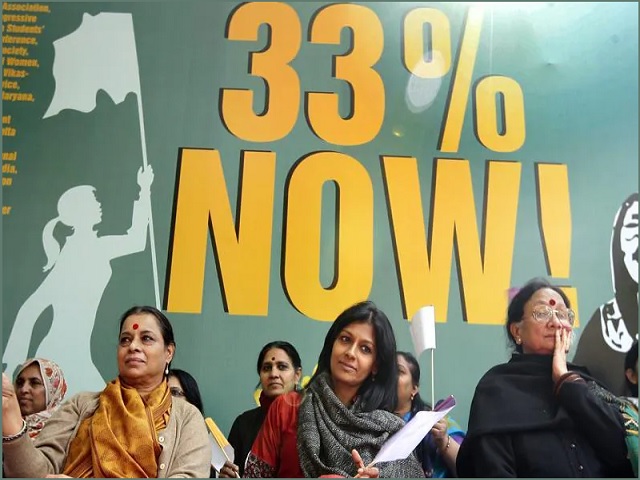Anjum Manhas
There comes a point when a dream becomes reality, a dream so distant forgotten in times. As India inspires to be a global superpower, PM Modi’s latest political punch is Reservation of Women in legislature. Democracy has to be vibrant. It involves participation of all the sections of the society. India was in fact one of the first countries to empower its women with political rights. Universal franchise is a constitutional right. Every citizen above the age of 18 years is entitled to vote. The idea of democracy is deeply buried in our society. As such to increase women participation in political sphere reservation is necessary as the opinion of half of population cannot be ignored. It paves way for woman empowerment, women centric laws, woman participation, sense of responsibility and more importantly it nourishes a idea of democracy.
History of Women Representation in Lok Sabha
The journey of women’s representation in the Indian Parliament began in 1951 with 22 women Members of Parliament (MPs) out of a total of 489 seats, constituting 4.50% of the Lok Sabha. In 1957, the number of women MPs remained the same at 22, with a slight decrease in percentage to 4.45%.The year 1962 saw a positive shift as the number of women MPs increased to 31, representing 6.28% of the total seats. In 1967, there were 29 women MPs, with women accounting for 5.58% of the Lok Sabha. Subsequently there was mariginal decrease In 1971, 28 women MPs were elected, making up 5.41% of parliamentary seats.1977 marked a significant dip in women’s representation, with 19 women MPs, constituting just 3.51% of the Lok Sabha. There was resurgence in 1980 as the number of women MPs increased to 28, representing 5.29% of the total seats. A significant milestone was reached in 1984 when 43 women MPs were elected, accounting for 7.95% of the Lok Sabha.In 1989, the number of women MPs again decreased to 29, making up 5.48% of parliamentary seats. There was an improvement in 1991, with 39 women MPs representing 7.30% of the Lok Sabha. In 1996, 40 women MPs were elected, constituting 7.37% of the total seats. 1998 saw 43 women MPs, accounting for 7.92% of the parliamentary seats. 1999, there was a further increase to 49 women MPs, constituting 9.02% of the Lok Sabha. The number of women MPs was 45 in 2004, representing 8.29% of the total seats. A notable increase occurred in 2009, with 59 women MPs making up 10.87% of the Lok Sabha. The highest percentage of women MPs during this period was recorded in 2014, with 66 women MPs representing 12.15% of the parliamentary seats. In the present Lok Sabha, which is the lower house of the Indian Parliament, there are currently 78 women Members of Parliament (MPs).
These figures illustrate a gradual but progressive increase in women’s representation in the Lok Sabha over the years, underscoring the importance of ongoing efforts to promote gender equality and women’s participation in Indian politics. While significant strides have been made, achieving gender parity remains an ongoing challenge, and continued initiatives are crucial to further empower women in the political arena.
History of Legislative Process
In 1971, Union Ministry of Education and Social Welfare appointed a Committee on the Status of Women in India (CSWI) to examine the constitutional, administrative, and legal provisions that had a bearing on the social status of women, their education, and employment and the impact of these provisions.
In 1987, Rajiv Gandhi’s government constituted a 14-member committee under then Union Minister Margaret Alva, which presented the National Perspective Plan for Women, 1988-2000 to the Prime Minister the following year. Among the committee’s 353 recommendations was the reservation of seats for women in elected bodies.
Finally, the Women’s Reservation Bill, was first introduced as the 81st Amendment Bill in the Lok Sabha in 1996 by the then United Front government led by Deve Gowda and was later pushed by the Atal Bihari Vajpayee-led NDA government in 1998, which aimed to provide 33% reservation for women in legislative bodies. Despite multiple attempts to pass it over the years, including in 1999, 2002, and 2003, it faced stiff opposition and never became law. It gained momentum during the Manmohan Singh-led UPA-1 government and was passed in the Rajya Sabha in 2010 but was never taken up in the Lok Sabha and eventually lapsed in 2014. The bill faced opposition from parties like the RJD and the Samajwadi Party, which demanded caste-wise reservation for women instead of gender-based quotas.
Women Reservation in Local Bodies
In India, women’s reservation in local bodies represents a significant stride toward achieving gender equality and empowering women in grassroots governance. Enacted through the 73rd and 74th Constitutional Amendments in 1992, it mandates the reservation of one-third (33%) of seats in Panchayats (rural local governments) and Municipalities (urban local bodies) for women. This reservation percentage also includes seats allocated for Scheduled Castes (SCs) and Scheduled Tribes (STs).
Significance
The significance of women’s reservation in legislative bodies is multifaceted and profound. Firstly, it serves as a crucial instrument for advancing gender equality in the realm of politics, rectifying the historical under representation of women in positions of power. This, in turn, empowers women to actively participate in decision-making processes, thereby fostering a more inclusive and equitable society. Furthermore, women’s reservation brings diverse perspectives to governance, enhancing policy formulation by considering a broader range of issues. It also provides vital role models, inspiring future generations of women to engage in public service and challenge gender stereotypes. Additionally, women in political leadership can advocate for legal and social reforms that benefit women’s rights and gender equality, contributing to broader societal changes. By fulfilling international commitments to promote gender equality and reshaping societal norms, women’s reservation not only paves the way for a fairer society but also fosters holistic and sustainable development, considering the diverse needs and aspirations of the entire population, irrespective of gender.


